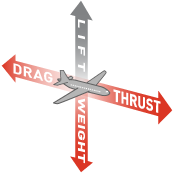The Rules of the Cosmic Road
How do you change your altitude in orbit? Or turn, slow down, or speed up? How can you slip free of Earth’s gravity? You need to know the laws of motion and gravity discovered by English physicist Isaac Newton, and the laws of orbital motion discovered by German astronomer Johannes Kepler.

Newton’s law of universal gravitation and laws of motion are named after Sir Isaac Newton, an English physicist, mathematician, and astronomer. Newton first published his work Philsophiae Naturalis Principia Mathematica (Mathematical Principles of Natural Philosophy) in 1687. Newton’s law of universal gravitation states that gravitational force decreases with distance and mass. Newton’s laws of motion describe the relationship between forces acting on a body and its motion due to these forces. Newton used universal gravitation, along with his laws of motion, to substantiate Kepler's laws of planetary motion.
Newton’s First Law Describes How an Object Moves When No Force Is Acting on It
A stationary object remains at rest until you apply a force to it. Once you set it in motion, the object continues to move at a constant speed until it strikes another object.
In the same way, a spacecraft far from any source of gravity would need no thrust to keep it moving at a constant speed in a given direction. Once set in motion, it will keep moving forever without propulsion, since there is no friction in space to slow it down. But it does need an additional force—thrust—to change its speed or direction or both.
Newton’s Second Law Describes How Force and Acceleration Are Related
The more mass an object has, the more force you must apply to make it accelerate—to change its speed or direction or both.
So, the more you want a spacecraft to accelerate, the more force you must apply. To reach a certain speed you can apply a small force for a long time or a large force for a short time.
Newton’s Third Law States that Every Action Has an Equal and Opposite Reaction
To stop or slow down an object, a force must be applied in the direction opposite to that of the object’s motion. Exerting a force results in an equal force in the opposite direction (like the recoil a person feels when firing a gun).
When a spacecraft fires a thruster rocket, the exhaust gas pushes against the thruster and the thruster pushes against the exhaust gas. The gas and rocket move in opposite directions.





